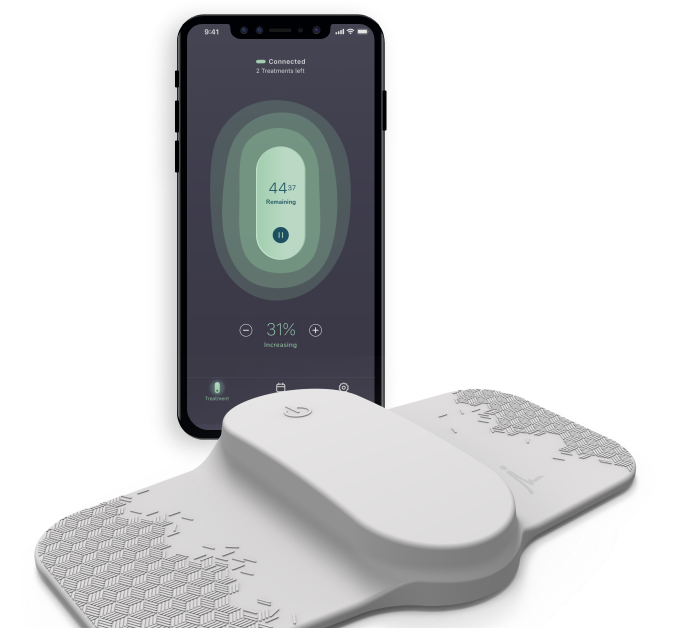22 Dec. 2020. Findings from a clinical trial show a wearable device sending electronic signals into the nervous system relieves migraine pain in children age 12 to 17. Interim results from the trial testing the Nerivio system developed by Theranica Bioelectronics Ltd. in Netanya, Israel appear in yesterday’s issue of the journal Headache (paid subscription required).
Migraine is a neurological syndrome causing severe headaches along with nausea, vomiting, and extreme sensitivity to light and sound. In some cases, migraines are preceded by warning episodes called aura including flashes of light, blind spots, or tingling in arms and legs. The web site Migraine.com estimates 37 million people in the U.S. suffer from migraines, and cites World Health Organization data indicating migraines affect 18 percent of American women and 7 percent of men.
Researchers, led by neurologist Andrew Hershey at Cincinnati Children’s Hospital in Ohio, are seeking better migraine treatments for adolescents with migraines. Current drugs for migraine, say the authors, can cause adverse effects not experienced in adults and may lead to overuse. For this population, the team tested the Nerivio system, already authorized by the Food and Drug Administration for use in adults age 18 and over, when prescribed by a physician.
The Nerivio system uses a patch worn on the upper arm, with electrodes sending out electronic pulses that stimulate C-fiber nerves and block pain signals from reaching the brain. C-fiber nerves are one of the pain pathways in the nervous system. When a migraine occurs, the individual straps on the Nerivio patch and activates nerve stimulation through an accompanying smartphone app for about 20 minutes. The app’s software also checks for proper placement of the patch, monitors the neuromodulation session, and can link to health care providers that need to be alerted.
The clinical trial enrolled 60 participants, age 12 to 17 at 12 sites in the U.S., experiencing migraines for at least six months. Participants wore the Nerivio system for eight weeks, following a four-week preparation and pre-treatment testing period. The study team looked primarily for any adverse effects from the Nerivio device, as well as the number of participants dropping out of the trial as an indicator of tolerability. Researchers also measured pain relief, pain freedom, and lack of associated symptoms for two hours after treatment, as well as sustained pain relief for 24 hours.
Clinical trial results
Of the original 60 participants, 14 failed to complete the preparation period and one individual did not take part in the follow-up, leaving 45 participants. Of those 45 individuals, 39 completed at least one remote neuromodulation session. The authors are reporting interim results, since the Covid-19 pandemic forced cutting short the trial.
The results show participants experienced 159 migraine headaches, with one-third (33%) considered severe and about half (49%) rated as moderate at the outset. After two hours following Nerivio treatment, 28 of the 39 participants or 71 percent, reported relief from their pain and 35 percent said they were pain-free. And nine in 10 participants (90%) reported pain relief or freedom for 24 hours.
Other findings show about seven in 10 participants (69%) could resume their usual activities, including school work, after two hours, confirmed by lower scores on a standard scale of migraine disability. One participant experience an adverse event, temporary pain in the arm. No serious adverse effects were reported.
“Migraine in adolescents can cause significant disruptions in school attendance and social interactions,” says Hershey in a Theranica statement emailed to Science & Enterprise. Hershey adds, “The possible addition of a drug-free treatment that is highly effective, and also safe and tolerable, will be an important option for patients, their families, and doctors looking to treat migraine for this age group.” The company says it plans to work with FDA to expand its authorization to include adolescents.
More from Science & Enterprise:
- Start-Up Company Creating Wearable Brain Scanner
- Start-Up Creating Digital Therapies for Alzheimer’s
- Therapist-Guided Home Stroke Rehab System in Works
- Trial Testing Magnetic Waves for Bipolar Depression
- Software Designed to Model, Visualize Brain Circuits
* * *


 RSS - Posts
RSS - Posts
You must be logged in to post a comment.